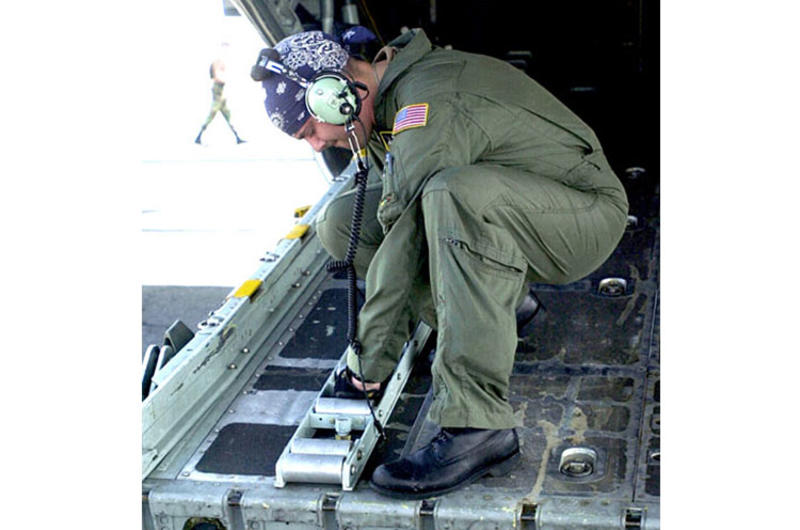

This website was created and maintained from May 2020 to May 2021 to commemorate the 75th anniversary of Stars and Stripes operations in the Pacific.
It will no longer be updated, but we encourage you to explore the site and view content we felt best illustrated Stars and Stripes' continued support of the Pacific theater since 1945.
Flying high — and low — at Balikatan

Air Force Staff Sgt. Ryan Crumrine, loadmaster with the 36th Airlift Squadron from Yokota Air Base, Japan, attaches rollers used to load and unload cargo on the C-130 after returning from a parachuting operation drop over Basa Air Field.
By Fred Zimmerman | Stars and Stripes March 2, 2004
CLARK FIELD, Philippines — Flying airplanes for a living can be a tricky business.
But taking a C-130 cargo plane and maneuvering it several hundred feet above the ground takes attention-to-detail to a whole new level.
Add in a mountain range to navigate and an automatic warning system barking out “terrain, terrain” every now and then, and the pilots and crew of the 36th Airlift Squadron from Yokota Air Base, Japan, are having a blast.
“Today was money,” said Capt. Eric Dopslaf, a navigator with the 36th. “This is some of the best flying I’ve done in five or six years. We have a lot of milk runs — taking cargo from point A to B — but this is fun.”
The unit is deployed to the Philippines for Exercise Balikatan 2004. They’ve operated out of Clark Field performing cargo drops, troop drops, low level flying and night-vision goggle flying, according to Capt. Helen Howell, the squadron’s mission commander.
“This is a fantastic training opportunity for us,” Howell said. “The practical training everyone is getting is unbelievable.”
Howell added that the unit is flying two planes each morning and three planes each night. She said the overall mission during Balikatan was to exercise the unit’s response to terrorist acts and human crises events.
Saturday’s mission for one of the unit’s C-130s was low-level flying through the mountains surrounding Clark Field before climbing to almost 10,000 feet to drop Armed Forces of the Philippines and U.S. servicemembers for a free-fall flight into Basa Air Base. The AFP jumpers were from the air force’s Special Operations Wing and their U.S. counterparts were Force Reconnaissance Marines.
“We wouldn’t get this kind of training at Yokota,” said U.S. Air Force Staff Sgt. Ryan Crumrine, loadmaster for 36th. “It’s an advantage to us coming down here.”
Crumrine said the High Altitude, Low Opening training held Saturday is something the unit doesn’t do often, but it’s one of the easiest. He said the jumpers are so experienced, they serve as the jumpmaster and he just sits back and watches.
As for the ride to the drop zone, Dopslaf said it’s something the unit doesn’t get the chance to do in Japan. He said with the weather and restrictions because of the population, low-level flying is rare. During the training here, Dopslaf said the pilots maneuver through the mountains anywhere from 300 to 500 feet above the ground.
“Low-level flying is used to limit the threat to the aircraft,” Dopslaf said. “We fly as low as we need to for the threat.”
Howell said the unit is flying every day but one during Balikatan and is getting more great training than just drops and low-level flying. She said the Philippines is great for night-vision goggle flying because of the low cultural lighting compared with Japan. Dopslaf said that during NVG flights, the planes maintain at least a 3,000-foot altitude in the mountains and drop to 2,000 feet above flat ground.
Taking the NVG training one step further, Howell said the pilots will practice blackout landings at Basa Air Base, using only the night vision equipment to land the plane. She said the training will make it similar to what the pilots would face in Iraq or Afghanistan.
“One of our pilots could be deployed to Iraq, so the training these guys are getting is great,” Howell said.
Howell said the success of the unit here isn’t just because of the operators, though. She said the maintainers and support personnel have been working 24 hours a day to make sure the pilots and crews can complete their missions.
The unit arrived here Feb. 23 and will head back to Yokota sometime during the second week of March.


